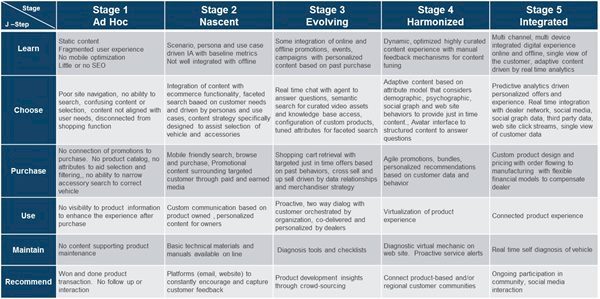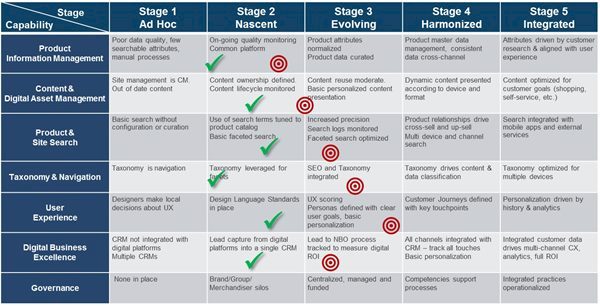This Article first appeared on CMSWire.
Gone are the days when a brand could get away with a mobile experience that's a miniaturized version of the desktop website. Gone too are the days when it was acceptable to forget a logged in customer's preferences on an e-commerce site.
One day's differentiator becomes the industry standard the next. Day by day, function by function, the bar is being raised across industries around convenience, access, ease of use and knowledge of customer needs.
Online and off, on web, tablet and mobile, in store, on digital devices or when speaking with an agent, customers expect the companies that they do business with to understand and anticipate their needs at every step, satisfy their wants and present them options even before they ask for them.
Keeping Up With the Speed of Technology Change
With the speed of change in tools and technologies, the only way to keep up is to continually develop competencies and capabilities that enable closer relationships with customers.
The digital experience is the means by which the enterprise interfaces with the marketplace. Digital experience maturity includes the processes behind the technology (the internal collaboration machinery that drives experience) as well as the multiple classes of technology that enable that experience.
Maturity in this sector is typically defined across multiple dimensions and includes difficult to quantify components, such as the extent to which digital technologies are aligned with enterprise strategy, or how fluent various parts of the organization are with emerging approaches and the state of the industry tools.
One marketing manager lamented, “Our tools are quite good — but we don’t have a deep enough understanding in our marketing organization to fully take advantage of them.”
Moving a global organization through the learning curve — especially as that learning curve changes and gets steeper as the industry evolves — is no trivial task. This is why digital is referred to as “transformation” — it involves major change, touches every part of the enterprise, and impacts (or is impacted by) culture and embedded work processes.
Mistaking Technology for Capabilities
A common mistake that leadership makes is to confuse a capability with a technology.
Adopting tools and integrating them with workers’ ongoing activities requires a considerable amount of effort. In order to succeed, a new capability needs to align with the current state of maturity and provide a path to increasing the maturity.
If it doesn't, or the path to the new capability is too disruptive, than an even greater investment of money and time will be needed to speed through the learning curve in order to minimize disruption.
One example of a significant change might be to create a more personalized user experience with dynamic content and contextualized messaging. Enabling this requires technology that serves up different combinations of content, an asset management system that can store and manage rich media assets, as well as a means of understanding and responding to user needs via messaging or offers through a rules engine or by statistical/machine learning algorithm.
While challenging, the technology is the easy part.
Many organizations that I have worked with have made significant investment in powerful technologies. However, once they decide they want to personalize a message, they need to figure out what message they want to send to each of their identified segments.
Questions related to processes come into play after the technology is purchased:
- If we are going to serve different messages to users, what are those messages?
- How can we componentize content and assets so they can be recombined?
- How do we monitor, test, measure and adjust the processes?
An organization intending to develop these capabilities needs maturity in marketing strategy, segmentation, machine learning, analytics, user experience, content operations, product information management, and a range of other processes.
Separating the Possible from the Practical
The best way to separate what is practical from what is possible is to periodically assess where the organization is on a maturity scale and where it should be based on its engagement strategy and desired capability.
A maturity model conveys to leadership where the organization is on its learning curve, what competencies are currently in place and what needs to be in place to support a new, more advanced capability. This analysis allows leaders to correctly allocate budget and resources to address gaps in serving the customer (or in serving the people who serve the customer).
Where the company is on the model itself is not important; what matters is the stage of maturity required for the intended process. That maturity stage can be based on a larger strategic goal (including competitive differentiators and go-to-market strategy) or on customer needs and expectations.
There are many models to choose from, and most are usually customized to the organization. The key is to define the competencies needed to support the new capability, and then determine far ahead the future state is compared with the current.
How to Use a Maturity Model to Guide Decision Making
There are five steps involved when starting with maturity models:
- Define the customer journey for your organization.
- Map out the existing capabilities for engagement at each step of the customer journey.
- Identify gaps or disconnects in the customer experience and define a future state vision.
- Locate where your company is on a customer experience maturity model (Table 1) and identify the future (desired) state on the model.
- For each stage of the journey, identify the supporting technologies required and their corresponding current and future maturities required to deliver the capabilities (Table 2).
Each gap has an impact on certain aspects of the customer journey. For example, if website search is hard or functions poorly for customers, they'll likely have trouble with the choose and purchase stages of the journey.
If your company wants to reach maturity stage 3 (Evolving) for the “choose” step of the customer journey, it will require maturity in product information, content management and search.
No direct correlation exists between customer journey maturity and digital capability maturity because a single digital capability such as content management can support multiple stages of the customer journey. Therefore your company may be in maturity stage 2 for content management but in maturity stage 3 for search.

Table 1 – Customer Journey Maturity

Table 2 – Digital Capability Maturity
The check marks indicate the current state of maturity and the target symbols indicate the needed maturity of the capability.
The digital capabilities can include any technology used to engage the customer and should include the tools in use or important to the organization. More nuanced methods are out there to define other customer engagement, lead generation or campaign management tool capabilities, but many tools leverage these core technologies or can be subsumed into one of the capabilities in the table.
The Value of a Maturity Model
A maturity model helps to align technology and process requirements with the needs of the customer, and to define realistic projects and funding.
If your organization is at stage 1 (Ad Hoc) and wants to reach stage 3 (Evolving) and each of the supporting technologies requires a two or three stage advance in maturity, a three-month project with $100,000 in funding will not succeed. A large enterprise can easily require up to a year to move from one maturity level to another (depending on the model).
A model is a way to illustrate how an organization gets from “here” to “there” and typically aligns with a digital transformation roadmap. Setting realistic goals and plans and having adequate funding helps advance capabilities and improve the customer experience — no matter where an organization is in its digital transformation.
